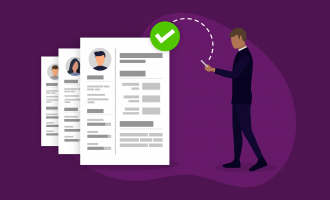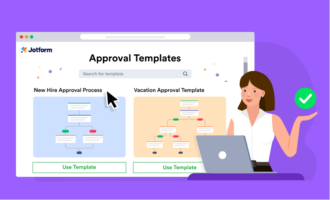Steps for human resource planning
A common thread in all businesses — regardless of industry, size, market, or geography — is change. It’s difficult to predict consumer and market trends, economic trends, employee sentiment, and customer behavior.
At the same time, businesses need to ensure they have the right people on their teams to meet whatever changes come their way. How is this possible? With effective human resource planning, businesses can anticipate their workforce needs and prepare for the challenges ahead.
What is human resource planning?
Human resource planning, which is sometimes referred to as workforce planning, is a systematic process that organizations use to determine who they need on the team to reach their business goals.
This type of planning includes developing a hiring strategy, forecasting needs, planning for recruitment, providing training and development, and optimizing people’s unique talents and skills.
The purpose of human resource planning is to minimize workforce, talent, or skill-set shortages and surpluses. When done effectively, it enables businesses to navigate any internal and external changes that could affect their operations.
Human resource planning should be in sync with the overall organizational strategy and business goals. If there’s a disconnect, the HR department won’t be able to effectively contribute to furthering company objectives. That’s why human resource planning needs to take a long-term approach and get buy-in from the organization’s leaders.
Why is human resource planning important?
Businesses conduct human resource planning because the process helps organizations reach their overarching goals. Related advantages include
- Preparing for future growth. Knowing how many staff you will need, when you’ll need them, and how much they will cost is a critical aspect of growing a business.
- Adapting to external changes. Planning helps businesses quickly pivot to respond to economic, market, consumer, legal, compliance, and competitive shifts.
- Meeting internal changes. Effective succession planning and career trajectory planning help the business prepare for any internal organizational shifts.
- Reducing organizational risks. A systematic and strategic approach to hiring and developing people, as opposed to hiring on a whim or without a plan, mitigates certain risks for the organization.
- Having the right skills. Planning ensures that organizations not only have the right number of people, but people with the specific skills they need to reach business goals.
Steps for human resource planning
Each organization should customize the steps involved in human resource planning to meet its individual needs. Industry, business size, customer segments, competitors, and other factors will all come into play, so you can’t follow the same approach as another organization.
Here’s a general outline of the steps to follow when creating your plan.
1. Understand and analyze company objectives
As with any kind of strategic planning, the first step in human resource planning is to establish the short-term and long-term goals the organization wants to achieve. Typically, these plans begin by outlining the vision, mission, and core values of the business — the “why” of the company. This helps clearly set the stage for what everyone in the business is working toward.
Outline specific business goals that have been established at the leadership level. Examples of these goals include increasing revenue by a certain percentage or becoming a market leader in a certain category over a certain period of time.
Having a clear set of measurable goals as part of the human resource plan provides a pathway for establishing which employees you’ll need to get the job done. For example, if one of the business’s goals is to increase sales of its enterprise product, then the business will likely need more people who have expertise in selling to enterprise customers.
In addition to the goals of the organization, other elements to consider during this first step include
- Budget allocation. Determine what the HR budget will be for the next fiscal year or several years. You’ll fine-tune this estimate in later steps after you’ve identified your specific human resource needs, but you’ll need a ballpark figure to work from.
- KPIs. Establish the key performance indicators for human resource management. How will the business measure success for your initiatives? This may include metrics for employee engagement, turnover, retention, employee sentiment, productivity, and cost per hire.
- Strategic partners. Identify who internally or externally will be a key partner in helping HR reach its goals. For example, internally this could include certain department managers or an executive. Externally, it may include a recruitment firm that focuses on a specific career category.
- Possible changes. Be sure to consider the likelihood that the long-term direction of the business may change. For example, if an executive leaves the company mid-year or if a competitor corners the market on a product, what will the future of the company look like?
- Feedback from the field. Be sure to check in with the people on the ground. High-level strategy often doesn’t include feedback from employees, which can lead to potential problems down the line. Including employee feedback in your strategy and human resource planning can provide insights you may not otherwise have.
2. Review the current environment
While the first step is to figure out where the business wants to go in the future, the second step is all about understanding where the business is in the present. In this stage of human resource planning, businesses need to conduct a detailed internal and external scan of their current environment and resources.
Internal
- Organize employees by skill. Outline the number of employees the business has currently, organized by specific skill sets or expertise that bring value to the business. A bakery, for example, may categorize employees by the type of baked goods each person specializes in, like cakes, breads, and pastries. For a tech company, employees may be categorized by their department, such as development, QA, marketing, and sales.
- Determine future potential. Understanding how employees can bring added value to the business is also critical. For example, if you invest in professional development for your employees, could they learn new skills and trades that can assist the business in reaching its goals? Is this preferable to hiring someone new who already has those skills?
- Consider possible changes. Are many employees set to retire in the next three years? Are some employees going to be promoted in the next fiscal year? Factor in likely changes to your current workforce and how that will affect your human resource plan.
External
- Look at supply and demand. Consider the labor market for the specific skill sets you’re looking for. Is there a shortage or surplus of those types of candidates in the market? Why? Is this likely to change soon?
- Review labor trends. Are there any trends within the labor market or within recruitment that may affect your plan? For example, a new technology could change the way people work or could change the types of skills people need to do specific jobs.
3. Forecast future demand
Now that you understand where the business wants to go compared to where it currently is, it’s time to get specific about what it will take to reach your goals. In some cases, it may make sense for human resource plans to begin with this step.
When forecasting future demand, keep the larger business goals of the company in mind, as well as the KPIs you’ve set for the HR department. Forecasting typically includes two separate elements:
- Quantitative forecasting. This refers to the number of employees you’ll need to accomplish the business’s goals. To determine this, review the measurable business goals. For example, if your goal is a 30 percent increase in sales, based on your typical sales cycle and customer acquisition process, you may estimate that achieving this increase will require hiring three salespeople and two marketing managers.
- Qualitative forecasting. This refers to specific expertise and skill sets you need to accomplish the business’s goals. To determine the type of employees your business will need, consider the methods of achieving business goals. For example, the business may require employees with exceptional leadership skills or expertise in Python.
Effective forecasting requires a combination of quantitative and qualitative elements. Taking one approach or the other won’t give you a complete picture of the right people the business needs to reach its goals.
4. Identify gaps within the business
In addition to forecasting, which looks at what resources your company will need, businesses also need to consider the supply of talent. Where will these employees come from? Will they be external hires or employees promoted from within?
In some organizations, this step is conducted simultaneously with forecasting. This aspect of human resource planning determines any gaps in your current organization that you need to fill.
Compare the forecast to the current talent pool within the business. Important questions to ask include
- Are there any current employees who can take on the roles you’ve identified in your forecast?
- If so, will they require any training or professional development?
- What’s the cost of this training and professional development?
- How long will the training and professional development take before the employees have the skills and expertise they need to fulfill the new role the business requires?
- Will you require additional employees to take on recently vacated roles, or will those roles be made redundant?
- Will you require succession planning or transition planning for any recently vacated roles?
- How many employees will you need to hire from outside the organization? What kind of skills, expertise, or work styles will those employees need to have?
Keep in mind that for many organizations, recruiting, hiring, and onboarding a new employee is costly and time-consuming, which is why many organizations prefer to look internally to fill gaps before looking externally. Once the organization has determined the gaps that can’t be filled internally, it can begin to consider external sources of hiring and contracting.
5. Develop a human resource action plan
Next, it’s time to create an actionable step-by-step plan to fill the resource gaps you’ve identified. There are three key ways to fill the gaps:
- Train and develop existing employees. By upskilling or reskilling employees, organizations can meet their business goals with people who already know their core values, processes, and systems. Doing so can save considerable time and resources compared to recruiting, hiring, and onboarding new employees.
- Hire new employees. In many cases, the organization won’t have the current quantity or quality of employees needed to achieve its business goals and will need to look externally for new employees. Explore multiple recruitment channels, such as referrals, direct recruiting, or working with a recruiting agency to determine what’s right for the business.
- Outsource specific projects or tasks. In some cases, outsourcing the role to another business or consultancy may be the right move. This is typically done for project-related work that isn’t the equivalent of a full-time role.
In addition to deciding how you’ll fill the employee gaps within the organization to reach business goals, outline your
- Schedule. How long will it take to complete the hiring or training activities you’ve identified, and when can the business expect to see results?
- Budget. What will the hiring or training activities cost, and how does that fit with the original budget outlined in step one?
- Priorities. Be sure to identify the order of importance for all human resource planning activities.
- Culture. How will you ensure that the mission, vision, and core values of the business are consistently communicated to new and existing employees during this period of change? How will the corporate culture of the business change or remain the same?
- Communication strategies. How will you share the organizational changes being made with existing employees? Keep in mind that organizational changes can cause stress and feelings of uncertainty among employees if they aren’t kept informed.
6. Put the plan into play
One of the most challenging parts of human resource planning is the actual implementation of the plan. The human resource management team will need to roll up their sleeves and begin the hard work. Here are tips to make implementation easier and more effective:
- Ensure executive approval and buy-in. Once you’ve created the action plan, be sure to get buy-in from the leadership team. While the executive team has likely been involved in earlier aspects of human resource planning, such as identifying business goals and budget, it’s still important to get formal approval and advocacy.
- Delegate tasks clearly. Ensure the human resource management team understands what each person is responsible for and when they need to accomplish it. For example, one person may be responsible for training existing employees, while another may be responsible for recruiting efforts.
- Use technology solutions to automate and track activities. Manually keeping track of which training employees have taken or which part of the recruitment process each candidate is in can be challenging and time-consuming, and can lead to inaccuracies or human error. Consider using a human resources management system (HRMS) to automate specific processes within your action plan.
- Communicate often. Keep the organization informed of progress at regular intervals, such as weekly or monthly. This way, there won’t be any surprises, and business leaders will be aware of the plan’s progress at each step.
7. Monitor and adjust the plan as necessary
The key to success for any type of strategic planning is to monitor and measure results. However, this step is often forgotten, and many organizations don’t take the time to review KPIs and make necessary adjustments.
For human resource planning, it’s critical to review the progress of the plan at regular intervals and see the relationship to the desired results. If something isn’t working or is behind schedule, it requires special attention. If something is tracking ahead of schedule, the business may be able to learn from it and replicate the strategy in other areas.
Set up a process for tracking progress and measuring KPIs. This may be as simple as setting up a weekly meeting with the members of the team who are implementing the plan, and discussing what activities they have completed and whether they’re facing any obstacles.
It can also include human resources management system (HRMS) reporting tools for tasks like measuring progress on employee training and recruitment. Determine the most effective way for your organization to understand progress and measure success.
If something isn’t working as hoped, develop a strategy to correct your course. For example, if the business isn’t able to recruit employees with specific career expertise directly, you may need to work with a specialized recruiting agency. Be sure to communicate any strategic changes to the stakeholders involved so there are no surprises.Human resource planning is a strategic way to position your business for success and ensure it has the right number of people with the right kind of skills. Follow the steps outlined above to ensure you consider both internal and external factors that can affect the future direction of your business. Remember to actively monitor progress and adjust the strategy as needed to ensure the business reaches its goals.
Want the full rundown on the topic? Check out the complete guide we created on human resource management.












































Send Comment:
2 Comments:
More than a year ago
thank you
More than a year ago
Great post. I also believe that HR planning is a systematic process. An effective HR plan aims to minimize workforce shortages or surpluses while maximizing employees' potential by matching their talents with organizational needs as closely as possible. In addition, the HR application software should be able to create good communication between all stakeholders, including management, staff members, family members etc., so they can work together more effectively and provide solutions rather than problems